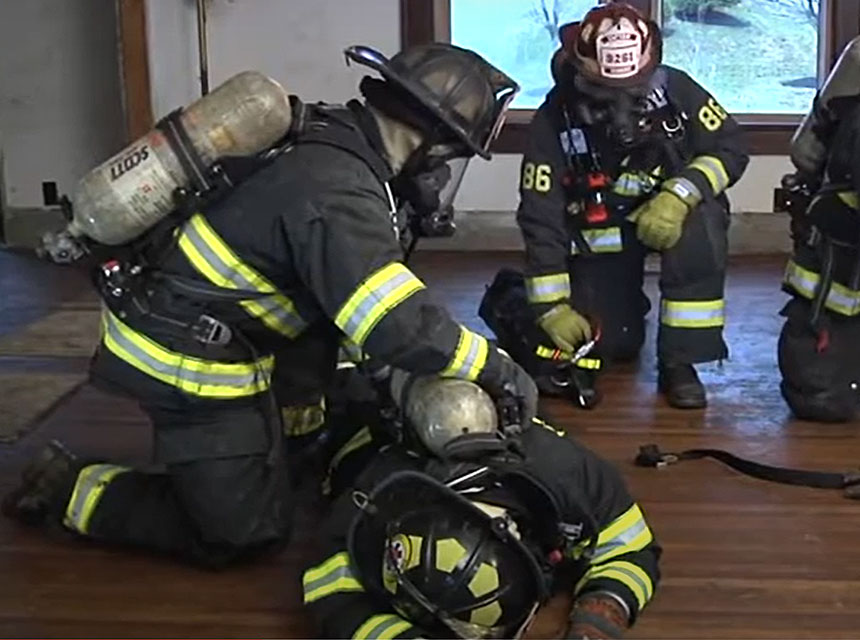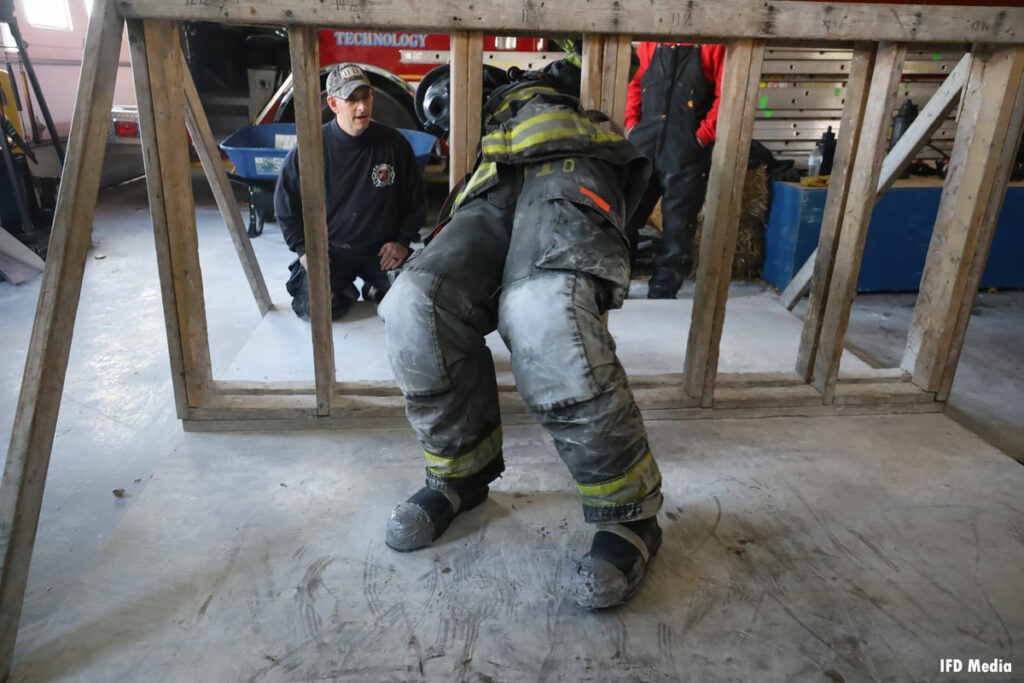
Firefighters work through months of a fire academy and then years in the field where they gain experience in driving fire apparatus, extinguishing fires, protecting property, and rescuing civilians. These firefighters are skilled in serving members of the community and are excellent at all the tasks they regularly perform as a team. However, it isn’t always only citizens who need to be rescued. Sometimes firefighters need to rescue each other or rescue themselves from events like a building collapse, a fall into a basement, or even being low on air while deep in a burning building. The personal protective equipment (PPE) and self-contained breathing apparatus (SCBA) firefighters wear make movement and rescue more difficult because they add weight, reduce movement, and limit visibility and communications. These challenges require specific training to overcome. A lost or injured firefighter also creates a high-stress events that happen infrequently; because of this, firefighters receive training on how to effectively rescue fellow firefighters and themselves. This training is often called fireground survival training or Mayday: firefighter down.
- Firefighter Basics: Calling the Mayday
- Your First Mayday Shouldn’t be the Real Thing!
- Training Minutes: Calling the Mayday
- Radio Messaging Under Warlike Conditions
A Mayday is an internationally known radio distress signal used by firefighters who are in a life-threatening situation or the situation they are in could become life-threatening. Fire academies offer basic Mayday instruction. There are also additional classes firefighters can take that involve this subject matter. Some departments offer the additional training. However, other firefighters will need to get training from private entities or state funded classes. There are two kinds of Mayday or fireground survival classes: the online or “book” learning portion and then the hands-on drills. Some training centers combine the two parts into one training. Hands-on drills put firefighters into positions where they physically have to rescue each other. The book portion of the class is usually called an awareness level class and focuses on what a Mayday is, when to call one, and how to call one. In the hands-on drills, firefighters will be wearing their PPE and SCBA while they are actually communicating over the radio and rescuing their fellow firefighters. This portion can be very physically demanding. It can be a lot of fun working with crews during a firefighter survival class. However, it can be emotionally exhausting as well.
The hands-on evolutions, or drills, in a firefighter survival course are created around actual situations where firefighters perished because they either could not rescue themselves or the crews could not remove the downed firefighters before they expired. Also, a firefighter is never a victim—civilians can be victims of a fire. The term for the firefighter who needs assistance is “downed firefighter” or “down firefighter.” The common firefighter rescue drills undertaken in these types of classes are the Denver Drill, the Nance Drill, and the Pittsburgh Drill, to name a few. Each of these training drills is associated with at least one down firefighter who was killed in the line of duty. This is called a line-of-duty death (LODD). To avoid an LODD, it is important for firefighters to have situational awareness, know when to call the Mayday, know how to call the Mayday, and work as a team throughout rescue attempts. These drills, along with the National Institute for Occupational Safety and Health (NIOSH) reports detailing exactly what happened during the incident, show firefighters that it takes more than one person to address a Mayday and having a plan that is practiced frequently is what will save lives.
- Proactive RIT: Preventing a Mayday
- Control, Command, and Communicate to Manage the Mayday
- Handling the Mayday: The Fire Dispatcher’s Crucial Role
- The IC’s Guide to a Mayday Response

Mayday and fireground survival classes also teach firefighters how to save themselves by doing hands-on evolutions in profiling, air management, and disentanglement. Profiling means turning your SCBA and body to be able to fit through small openings. For example, firefighters learn how to break through drywall and fit their bodies, while wearing all their PPE, through the space between the wall studs. Firefighters would perform this type of maneuver to escape a room where they are trapped. This is not something that will be performed often, so it is important that firefighters learn how to do it, when to do it, and actually practice the skill so it can be remembered when in a high-stress environment. The same is true for the air management and disentanglement skills learned in these classes. These skills need to be learned and practiced so they can be performed while under extreme duress.
YOU MUST CALL MAYDAY FOR RIT TO WORK: WILL YOU?
One big part of these courses is learning when to call a Mayday. This is important because firefighters can wait too long before calling one due to concern about how people will see them if it wasn’t really a Mayday situation. This can lead to injury and death. It can also make the situation more difficult for the crews that will work to rescue the down firefighter. Because of this, a large part of the class is focused on learning when and how to call a Mayday. For example, a firefighter may become lost in a commercial structure where the visibility is very low. If the firefighter does not call a Mayday and instead chooses to find his way back to the exit, he can become further separated from his crew and unknowingly move further away from the entrance. This can cause an air management issue where the firefighter does not have enough air to get out of the building even if he is found before his SCBA is empty. There have been LODDs that have occurred in similar situations. In 2001, Firefighter Paramedic Bret Tarver died after running out of air and becoming disoriented inside of a large supermarket1. The rescue and recovery efforts were extensive and 12 additional Maydays were called during the rescue attempt.
There is a vast amount of knowledge about Maydays—way too much to go over in one article. The important thing for new or future firefighters to remember is that training exists on this topic and there are many ways to participate in Mayday training activities. Check out the International Association of Fire Chiefs2 and International Association of Fire Fighters3 Mayday and fireground survival opportunities and take advantage of these resources. There may also be classes sponsored by your state department of fire programs or similar agency. Opportunities to learn more about this subject are also offered at conferences and through private training organizations across the country; keep an eye out for classes near you and stay safe!
- https://www.phoenix.gov/firesite/Documents/072604.pdf
- IAFC: https://www.iafc.org/docs/default-source/1leadership/ifoc2019_firefighter-mayday-course-cirriculum.pdf
- https://www.iaff.org/fire-ground-survival/

Mandy George is a retired lieutenant in the Chesapeake (VA) Fire Department. She has a master’s degree in emergency and disaster management, a master’s degree in professional writing, and an associate’s degree in emergency medical services. She is also a Nationally Registered Paramedic (NRP) and a Virginia Office of Emergency Medical Services (VAOEMS) Education Coordinator.
FIRE SERVICE 101
Introduction to the Fire Academy: Hoselines, Water Supply, and Academy Graduation
Introduction to the Fire Academy: Confined Space, Vehicle Extrication, and Live Burns
Introduction to the Fire Academy: PPE, SCBA, and Ladders

